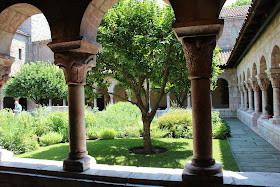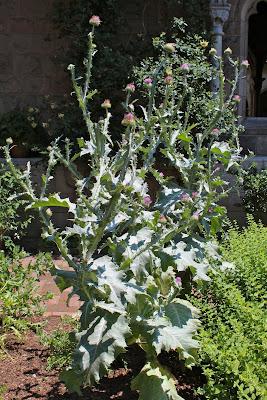1. a covered walk, especially in a
religious institution, having an open arcade or colonnade usually opening onto
a courtyard.
2. a courtyard, especially in a
religious institution, bordered with such walks.
3. a place of religious seclusion, as
a monastery or convent.
4. any quiet, secluded place.
5. life in a monastery or convent.
In Fort Tryon Park in Washington Heights lies one of the jewels of New York—the Cloisters. A branch of the Metropolitan Museum
of Art devoted to medieval European art and architecture, the building and its gardens are a perfect place to escape from the chaos of the city.
The Cloisters is comprised of bricks and architectural details from five different French cloistered abbeys, which were shipped over to New York and reassembled during the 1930s. The authenticity of the building and its gardens allows you to feel as if you have stepped into the past. And it’s awfully calming to boot.
The Cloisters is comprised of bricks and architectural details from five different French cloistered abbeys, which were shipped over to New York and reassembled during the 1930s. The authenticity of the building and its gardens allows you to feel as if you have stepped into the past. And it’s awfully calming to boot.
"The Unicorn in Captivity" (1495-1505)
Medieval art is not my favourite yet it’s hard not to be impressed by some of the works here. My favourite was the Unicorn Tapestries Room in which seven exquisite tapestries tell the story of the hunt and subsequent killing of a unicorn. While the ending is horrible, the tapestries themselves are absolutely stunning.
Other works that caught my eye were from top a statue of my man St. Michael (Spanish, ca. 1530); the double tomb of Don Àlvar Rodrigo de Cabrera, Count of Urgell and his wife Cecília of Foix (Spanish, ca. 1300-1350); and a crucifx (Spanish, ca. 1150-1200).
 Cuxa Cloister Garden
Cuxa Cloister Garden
Outside in the gardens, the serene beauty was a welcome sight. In the quiet Cuxa Cloister Garden sparrows hopped around as the sun bore down on the plants and visitors below.
It was extremely hot the day of my visit so ducking under the protection of the covered passageway was a welcome relief.
There weren't a whole lot of flowers in bloom in the garden but there were these lovely white Bellflowers.
Lunch was had at the café in the tiny Trie Cloister Garden where I was able to gaze upon my favourite flower—the Hollyhock.
Bonnefont Cloister Herb Garden
 A wattle fence
A wattle fence
The Bonnefont Cloister Herb Garden with its central wellhead was more crowded but just as lovely. Most of the 250 plants here would have had a use either for cooking or medicinal purposes during Medieval times.
The smell of lavender and fennel filled the heavy air while I checked out the offerings including giant Cotton Thistles and Fuller's Teasel. So many other plants and flowers to rave about. I can't wait to return in the fall and see how the gardens have changed.
The Cloisters is open year round and although it's a bit of a trek, it's well worth the trip.
Image of "The Unicorn in Captivity" from the Met. Photos by Michele.













No comments:
Post a Comment